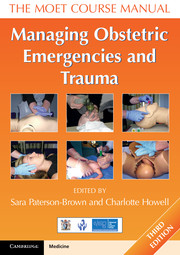Book contents
- Frontmatter
- Dedication
- Contents
- Working Group
- About the authors
- Acknowledgements
- Abbreviations
- Section 1 Introduction
- Section 2 Recognition
- Section 3 Resuscitation
- Section 4 Trauma
- 13 Introduction to trauma
- 14 Domestic abuse
- 15 Thoracic emergencies
- 16 Abdominal trauma in pregnancy
- 17 The unconscious patient
- 18 Spine and spinal cord injuries
- 19 Musculoskeletal trauma
- 20 Burns
- Section 5 Other medical and surgical emergencies
- Section 6 Obstetric emergencies
- Section 7 Triage and transfer
- Section 8 Human issues
- Index
17 - The unconscious patient
- Frontmatter
- Dedication
- Contents
- Working Group
- About the authors
- Acknowledgements
- Abbreviations
- Section 1 Introduction
- Section 2 Recognition
- Section 3 Resuscitation
- Section 4 Trauma
- 13 Introduction to trauma
- 14 Domestic abuse
- 15 Thoracic emergencies
- 16 Abdominal trauma in pregnancy
- 17 The unconscious patient
- 18 Spine and spinal cord injuries
- 19 Musculoskeletal trauma
- 20 Burns
- Section 5 Other medical and surgical emergencies
- Section 6 Obstetric emergencies
- Section 7 Triage and transfer
- Section 8 Human issues
- Index
Summary
Objectives
On successfully completing this topic, you will be able to:
describe the principles of treatment of the unconscious patient
understand the concept of secondary brain injury and how to prevent it
identify types of lesion amenable to surgery (extradural and subdural haematoma).
Incidence
Each of the last three Confidential Enquiries have described approximately 40 indirect deaths in women due to disease related to the central nervous system. These include deaths from: subarachnoid haemorrhage; intracerebral haemorrhage; cerebral thrombosis and epilepsy.
The immediate management of the patient unconscious from any cause should be a basic skill of every obstetrician and midwife. The obstetric team should be aware of the potential causes of a decreased level of consciousness and treat the underlying cause, with appropriate specialist assistance where necessary.
Causes of decreased level of consciousness
A B Failure of airway or breathing: hypoxia/hypercarbia
C Failure of circulation: shock or cardiac arrest
D Failure of central nervous system:
• eclampsia or epilepsy
• intracranial haemorrhage, trauma, thrombosis, tumour or infection
• drugs, alcohol or poisoning.
Principles of treatment
Although these principles were developed in the context of trauma cases and traumatic brain injury, the same principles apply to any medical situation that threatens the supply of oxygen to the injured or uninjured brain.
Primary and secondary brain injury
Primary brain injury is the neurological damage produced by the initial event, such as a brain haemorrhage. Secondary (further) brain injury is the neurological damage caused by lack of oxygen delivery to the brain. This may be caused by:
• A B – failure of ventilation, caused by airway obstruction or inadequate breathing, resulting in poor oxygenation. In addition, both airway obstruction and inadequate breathing may lead to a rise in arterial carbon dioxide levels. This has direct consequences on intracranial pressure (ICP) (see below).
• C – failure of circulation due to shock including hypotension.
• D – intracerebral damage may cause an excessive rise in ICP, leading to reduced cerebral perfusion pressure (CPP).
- Type
- Chapter
- Information
- Managing Obstetric Emergencies and TraumaThe MOET Course Manual, pp. 189 - 200Publisher: Cambridge University PressPrint publication year: 2014

